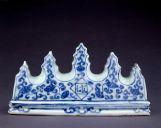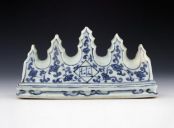More peaks
Several other brush rests, very similar in style and design, survive from the Zhengde period. Look at the different examples: all of them are of a similar size, they all have five peaks allowing four brushes to rest upon their valleys, and the shapes of the mountains are clearly outlined. There are inscriptions on each surface center, either in Arabic or Persian.
The brush rest in the Hong Kong Museum of Art (fig. 3) is extremely similar to the brush rest in the Metropolitan Museum, with the same inscriptions and decorative patterns. Jingdezhen was the official kiln in the Ming Dynasty and produced imperial porcelain on a massive scale. It may suggest that that brush rest, like the brush rest at the Metropolitan Museum, was one of the more mass-produced court objects during that time.
In the Zhengde period many objects shared a similar design. Inkstones, jars, and censors were also produced for the Muslim community. However, the inscriptions on these objects are not descriptions of the object, but rather poems or quotes.
The previous design did not remain fashionable for long. Besides the Zhengde period, similar designs on par with the brush rest with Persian inscriptions are rare. The Persian influence diminished after the Zhengde period with the emergence of new styles in the later periods.
Our brush rest is special, a peaky reflection of the emergence of the interconnected world of the 16th century.
](https://micrio.thingsthattalk.net/DoNEE/views/max/191x128.jpg)

